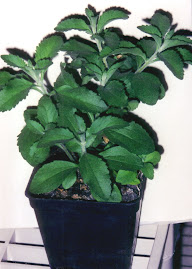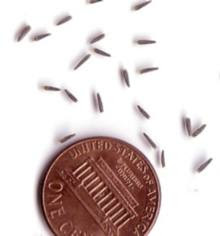aphids—Soft-bodied, sap-sucking insects from 1–5 mm long. They sometimes infest tender young stevia leaves and stems. Infestations are usually not serious outdoors. More often, aphids are a problem indoors or in greenhouses. Controlled by insecticidal soap or insect predators such as ladybugs or lacewings.
cell pack—A container for starting plants—usually small plastic pots or “cells” attached in a group. The most common size is a 6-pack. Twelve 6-packs fit in a standard nursery flat for a total of 72 plants. Nursery flats with cell packs are widely available at general merchandise stores or by mail order and are ideal for starting large numbers of stevia or other bedding plants.
compost—Decomposed organic matter that can be used as a soil amendment or growing medium. Often part of potting soil or seed starting mixes. Mixed into garden soil, improves soil structure and fertility. In most soils, compost is the only fertilization necessary for successful stevia production.
cutting—A section of plant stem used for asexual propagation. Stevia cuttings in a coarse growing medium produce roots easily.
dehydrator—Appliance with shelves or trays designed to dry food using low heat and circulating air.
direct seeding—Planting directly in the ground outdoors. Not recommended for stevia because of small size and high cost of seeds.
drip hose—Special water hose used for drip irrigation. Water weeps or drips slowly from emitters tiny holes.
drip irrigation—A watering method that minimizes water use and prevents wetting of plant leaves by slowly dripping water on the soil surface or from a hose buried below the surface.
fish fertilizer—Fish-derived liquid or powder designed to provide major nutrients to plants. Useful for stevia grown in low fertility soils when used in a more dilute solution than usual.
genus—A taxonomic category consisting of a group of plant species with similar characteristics. Stevia is a genus name. Within this genus, only the rebaudiana species contains large amounts of sweet glycosides.
germination—Emergence from a period of dormancy. Seed germination is the beginning of a growth cycle for plants like stevia.
gluten—A type of protein found in many grains. Gluten-free ingredients are available for those with gluten intolerance.
glycemic index—A measure of how fast a food causes a rise in blood glucose levels upon consumption. Stevia is considered non-glycemic, causing virtually no surge in blood glucose levels.
glycosides—A group of molecules in which the sugar part is bound to another part. Certain glycosides, stevioside and rebaudioside A being the most prominent, are responsible for the sweet taste of stevia. Rebaudioside A is considered to have the best quality of taste. Some authors use the term “stevioside” to mean all the glycosides in the stevia plant collectively.
green manure—A plant being grown for the purpose of improving the soil rather than direct harvest.
greensand—A slow-release natural fertilizer formed in marine deposits. Supplies mainly potassium (potash) and many other trace minerals. It can be used in potting soil, as a garden soil conditioner, or as a top dressing.
Green Stevia Powder—Powdered dry stevia leaf. Easily made at home from dry leaves in a blender or with a mortar and pestle. Useful in some types of recipes.
insecticidal soap—Special soap designed to control certain pests such as aphids by a direct spray application.
last frost date—The average date of the last frost in the spring. Since stevia is sensitive to cold, it should not be put outdoors without protection until at least a couple weeks after your last frost date when the soil is warm. Find your last frost date online, at the library, or at your local university extension agency.
loam—Soil consisting of sand, silt, and clay, usually with a lower proportion of clay. Ideal for many plants including stevia.
mother plant—Plant from which material is taken for propagating new plants. Stevia can be started easily from stem cuttings.
mulch—A material placed on top of the soil, usually to hold in moisture during hot, dry periods. Organic mulches such a straw, leaves, or grass clippings also keep the soil cooler, provide food for earthworms, and gradually enhance soil fertility.
nursery flat—A shallow container for holding young plants. Can be fitted with a clear dome for seed starting. The most common U.S. size is about 11 inches (28 cm) wide and 21 inches (53 cm) long.
organic matter—Soil organic matter is plant and animal material that has decayed. Vital for optimum soil structure and fertility. Can be supplied by mulching with organic materials or incorporating compost into the soil.
over-wintering—Surviving through the winter season. Stevia is a tender perennial native to subtropical regions with mild winters. In cold climates, it usually needs to be brought indoors or otherwise protected from freezing temperatures over the winter. Artificial lighting helps as well.
perennial plant—A plant that normally lives more than two growing seasons. Stevia is a tender perennial, meaning it generally cannot survive outdoors where temperatures drop below freezing. It can be grown like an annual, however, replanted each year.
perlite—A type of volcanic glass. Horticultural perlite is very light weight. It has been expanded and has the appearance of small white beads. It adds air spaces to potting and seed starting mixes and is a good medium for rooting plant cuttings.
plant propagation—The process of reproducing plants. Stevia is usually propagated by stem cuttings or seed.
potting soil—A medium for growing plants in pots or other containers. Should have the proper balance of air space and water holding capacity along with the necessary nutrients.
pruning—Removing a portion of a plant. In the case of stevia, stem tips should be removed every few weeks during the early part of the growth cycle. This promotes beneficial branching.
quinoa flakes—Quinoa is a gluten-free grain sometimes used in the form of flakes. In some recipes, these flakes can be used in place of rolled oats or part of the flour.
raised bed—Usually a 3–4 foot (1-1.25 meter) wide mound of soil, sometimes surrounded by wood, concrete, plastic, brick, or some other edging to contain the soil. Good for growing stevia in areas where soil drains poorly or is heavy (high in clay content).
rock phosphate—Rock with a high proportion of phosphate minerals. Phosphate is one of the macro-nutrients needed by plants and may be supplied by fertilizers derived from rock phosphate.
short day plant—A plant that blossoms only under short day conditions. Stevia rebaudiana falls under this category. It generally produces blossoms only with enough hours of darkness in every 24 hour period. In Missouri, this usually happens in October, when it is too late for the maturing of seeds outdoors before the first frost. The long days of summer at high latitudes tend to suppress blossoming and encourage leaf production.
silica gel—A porous form of silica that can act as a desiccant (drying agent). Available as solid blue beads that turn pink when saturated. Can be dried out and re-used. Good for placing in a sealed jar with stevia seeds for long term storage.
(continued below)
simmering—A cooking technique in which a liquid is kept just below the boiling point. Done by bringing to a boil and then lowering heat until just a few bubbles are visible.
standing water—Water left on the surface of the ground after a rain. An area where water remains standing for a long time after a rain may be too waterlogged for optimum stevia production. A raised bed may help in such a situation.
steeping—Soaking something in a liquid. Steeping stevia leaves is part of the process for making stevia tea and stevia water extract.
stem rot—Fungal disease of plant stems and leaves. Encouraged by high humidity and cool temperatures.
Stevia—The genus name for a large group of plants and shrubs native to South and Central America. More commonly, the term is used for a particular species, rebaudiana, having a significant quantity of sweet glycosides.
Stevia Extract Powder—A white or off-white powder consisting mainly of one or more of the glycosides from the Stevia rebaudiana plant.
Stevia Leaf Water Extract—A greenish liquid produced by steeping dried stevia leaves in hot water.
stevioside—The most prominent glycoside found in Stevia rebaudiana. Some authors may use this term when referring to all the glycosides found in stevia collectively.
sun exposure—An expression of how much direct sunlight strikes a plant. In most places, stevia thrives with full sun or with afternoon shade. During the summer in hot climates, additional shade may be needed and can be provided by shade cloth or other material attached to some kind of frame.
tea ball—Usually a hollow metal ball with holes. Make stevia tea by immersion in hot water with leaves inside.
tea strainer—Basket-like sieve with a handle. Make stevia tea by immersion in hot water with leaves inside.
temperate climates—The climates predominating between the tropics and the polar circles or in higher altitudes of some tropical regions.
tender perennial—A plant like stevia that generally survives more than two growing seasons, but only where temperatures remain mostly above freezing all year. Stevia can be treated as an annual (replanted every growing season) in colder climates.
transplant—A young plant meant to be moved to a new growing location or the act of moving a plant to a new growing medium.
University Extension Agency—University based entity that educates the public on consumer issues, health, horticulture, and other topics in many states of the U.S.A.
USDA Hardiness Zone—Geographic zones based on what plants can grow well in the area. First established by the U.S. Department of Agriculture.
vermiculite—A natural mineral with a high cation exchange capacity. Horticultural vermiculite has been expanded and is light in weight. Useful for potting and seed starting mixes and the perfect covering for stevia seed germination.
viable—For seeds, this means having the capacity for germination under favorable conditions.
whiteflies—Tiny sap-sucking insects. They congregate mostly on the underside of leaves. Sometimes infest stevia, especially indoors. Control methods include insecticidal soap and predatory insects such as lacewings.
The above glossary is from Growing and Using Stevia: The Sweet Leaf from Garden to Table with 35 Recipes
Click here to order the book directly from Prairie Oak Publishing
Click here to order from Amazon.com
###




No comments:
Post a Comment